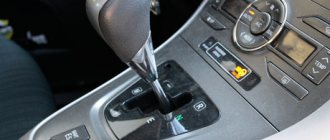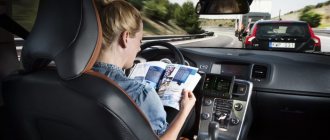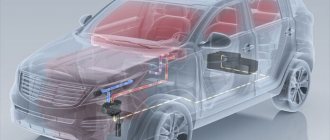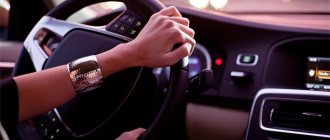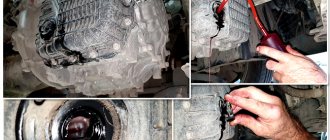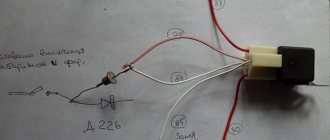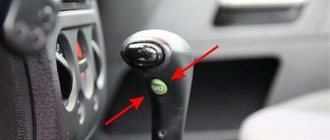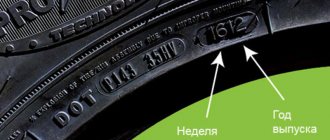Most modern motorists prefer vehicles with automatic transmission, but the level of awareness about the features of their operation is still quite low, in particular, many do not know whether it is possible to tow another car with an automatic transmission. There is no strict prohibition. However, towing cars with an automatic transmission requires taking into account a number of nuances so that the transmission does not fail.
Doubts
Sometimes towing is simply necessary. For example, a car is stuck in the snow and for certain reasons it is not possible to call a tow truck or rescue service. According to theory, every owner of a car with an automatic transmission knows that it is better not to take part in towing.
But what if any other means of help are not available? And if you think logically, the automatic transmission pulls loaded trailers quite well. How is another car attached to a cable worse? There shouldn't be any particular difficulties. Naturally, no one wants to risk their automatic transmission, but abandoning a friend or just a stranger on the highway is simply not nice. Drivers are a special people, and driver solidarity still exists among them. And many motorists have not even read the instructions for their car in order to say for sure whether it is possible to tow another car with an automatic car.
Types of automatic transmissions
Manufacturers equip modern cars with different types of automatic transmissions. Each of which has both advantages and disadvantages.
Hydromechanical automatic
The first automatic transmission to compete with manual transmissions. In fact, these are two devices: a torque converter and a planetary gearbox. Torque from the engine to the automatic transmission is transmitted using two turbines and transmission oil, which acts as working heat to engage gears.
The hydraulic automatic machine has a long service life, reaching 500 thousand km in some cases, and technologies that provide high driving comfort. Such a box requires regular technical inspection, high-quality working fluid, is afraid of high loads and is sensitive to overheating.
Variable speed drive
This box is less common and is seriously different from the previous version. Here, two pulleys mounted on the variator shafts are connected by a chain or belt. Depending on the load, the pulleys change diameter, which leads to a smooth change in torque on the wheels of the car.
There are no standard gear levels, so the box is called continuously variable. And since there is no gear change, owners of cars with a CVT note a smooth ride, the absence of jolts and jerks when driving, and at the same time good acceleration from a standstill and economical fuel consumption.
But there were some downsides:
- the variator reacts poorly to medium and high loads;
- its repair and maintenance are expensive;
- it is sensitive to the quality of transmission oil.
Robotic box
The peculiarity of such a box is that it is essentially a manual gearbox with one clutch, the operation of which is automated, as is the gear selection.
This is a less expensive automatic transmission than previous options, which significantly affects the cost of the entire car. In addition, fuel consumption is significantly reduced and dynamic acceleration is increased.
But there were also disadvantages:
- decreased ride comfort;
- sharp clutch control;
- not always clear gear shifting (jogs and jerks);
- the need to completely replace the device if it breaks down in most cases.
Preselective robotic box
This is an improved robotic box with improved characteristics. The point is that two gearboxes are placed in one housing: with even and odd gears and its own clutch. And while the car is moving in an odd gear, the even one is already connected and ready to go into action as soon as the clutch is engaged. Gear changes occur unnoticed by the driver, so the car moves smoothly and without jerking.
Such boxes consume fuel economically, accelerate faster and ride more comfortably compared to robotic ones, and are also less sensitive to loads and heat.
At the same time, selective boxes are expensive and have a shorter service life, requiring highly qualified repairs.
General set of rules for towing with automatic transmission
The weight of the vehicle to be towed must not be greater than the weight of the towing vehicle. It's better when it's smaller. Even if there are heavy loads in the other car, it is recommended to transfer them to the front car. This will be less dangerous for the automatic transmission. To the question “is it possible to tow another car of greater weight with an automatic machine,” auto experts answer categorically - no. Naturally, this does not apply to emergency and frankly extreme cases. It is important to check the oil levels in the box before the process. When towing, does oil consumption increase by about 1.5-2 times? and if there is not enough lubrication, then the service life of the box is reduced several times. Experts do not recommend using low gears when towing.
But that's not all. It is not recommended to switch even to position D. It is best to pull another car in 2-3 gear modes. Starting off and the movement itself should be as smooth as possible. You should not start abruptly, with jerks and other sudden movements. There are other recommendations, but they may differ depending on the make and model of the car, the type of automatic transmission installed and some other factors. If these conditions are met, towing is permitted.
Let's talk about the technical side of the issue
The first thing to note is the presence of several types of automatic transmissions, differing in design and operating principles:
- A torque converter automatic transmission is a classic transmission option, the peculiarity of which is that there is no connection between the wheels and the power unit. The torque converter acts as a clutch and transmits rotation to the wheels when the vehicle starts moving. In this case, the transmission of torque itself is carried out using transmission oil;
- The CVT is a continuously variable transmission with no gears as such. Structurally, a variator consists of several pulleys, between which the belt rotates. The side parts of the pulleys can move to one side or the other. Gear ratios change continuously (depending on the acceleration or deceleration of the car). CVTs are considered one of the most comfortable;
- A robotic automatic transmission is structurally similar to a “mechanical” one, with the difference that all the work is done by a servo drive (the latter is controlled by an electronic unit);
- Preselective automatic transmission - the “robot” version. Structurally, the device consists of two gearboxes located in a common housing.
Despite the variety of gearboxes, there should be no confusion - the towing rules for all cases are almost identical.
Differences from cars with automatic transmission
If a car with a manual transmission is being pulled, then in neutral gear only one gear will rotate in the mechanism. When a car with an automatic transmission is towed, the entire mechanism rotates in the neutral position. This concerns the question “is it possible to tow a car with an automatic transmission?” Since the automatic transmission mechanism was not created for such work, the automatic transmission will very quickly overheat in this mode and may well fail. Of particular note is the issue of lubrication. The oil pump only works when the engine is running. But, most likely, the car will be towed with the engine turned off, which means that the parts in the transmission system are not lubricated. This can lead to the automatic transmission simply failing, and the owner will face expensive repairs. If a car with an automatic transmission itself acts as a tug, then the transmission in this case experiences serious additional loads. And if in the case of a manual transmission there are no restrictions, then for an automatic transmission it is necessary to make certain “discounts” so as not to ruin the mechanism.
Weaknesses of automatic transmission
The practice of using automatic transmissions has shown that they have two “Achilles heels” - overload and overheating.
Ideally, such gearboxes are designed for use in urban conditions and on homogeneous surfaces. Any changes to standard operating conditions are fraught with consequences.
There are several negative points here:
- Slipping. When the wheel rotates quickly, the automatic transmission begins to upshift. Then the driver releases the gas, but the speed remains high, which is bad for an automatic transmission. At this moment, the gearbox experiences maximum overload. To avoid problems, when slipping, you must turn on manual mode. In this case, the automatic transmission is fixed in one gear, and the likelihood of overheating is reduced to zero.
- Surface change. There are often situations when wheels slip on a slippery road and then fly off onto a hard surface. As a result, the wheels stop and the automatic transmission takes a hit. The latter can break the shafts, which is quite possible. Also, friction discs suffer from such impacts, which can slip upon impact.
- Overheat. The automatic transmission radiator is designed for operation under normal driving conditions. If the car starts to slip for a long time, the device quickly heats up and the radiator is not enough to dissipate the accumulated heat. If the car is standing and slipping in one place, plastic valve bodies and solenoids are at risk. When the corresponding signal appears on the control panel, the automatic transmission should be allowed to rest and the car should be turned off for 20-30 minutes. After slipping, it is necessary to check the oil and replace it if darkened. All plastic elements may also melt.
As for SUVs, their automatic transmission can withstand a lot more load. In addition, such cars have low gears that are engaged manually or automatically.
Their essence is the absence of high speeds, which eliminates overheating of the automatic transmission and consequences for its elements.
It is SUVs, if we talk about automatic transmissions, that are most suitable for towing a car with an automatic transmission.
Car with automatic transmission as a tow vehicle
Manufacturers, answering the question “is it possible to tow another car with an automatic car,” recommend avoiding such situations. If there are no other solutions to the problem, then you need to follow certain rules.
So, it is better to give preference not to a traditional cable, but to a rigid coupling. As already noted in the general recommendations, the weight of the towed vehicle should not exceed the weight of the towing vehicle. The speed does not exceed 30-40 km/h. The transmission should not be in Drive.
It is better to set it to position “2” or “3”. Experts also recommend downshifting. This will help reduce the load on the transmission mechanism.
A bit of technology
How do automatic transmissions work in general? Despite all the differences in characteristics and design, the machines have one common quality - oil lubricates the internal mechanisms only when the power unit, that is, the engine, is functioning. If the engine is turned off, the gearbox will run dry, which causes heating, and then overheating and failure of its elements if a number of recommendations are not followed, which we will discuss below.
If you don't follow our recommendations, you may well end up needing a very expensive overhaul or replacement of the automatic transmission, so don't get carried away by high speeds and long distances while driving a towed car.
How to tow correctly
Since the automatic transmissions installed on different car models can differ significantly from each other, it is best to see whether it is possible to tow another car with an automatic transmission in the car’s instructions. There you can also find information on how long you can pull the car and what speed to adhere to. Manufacturers may set different parameters. But it's rare that they ban towing entirely. Of course, such advice is suitable if the need for towing is known in advance and there is the opportunity and time to study the instructions. When this is not possible (and such situations happen very often), experts and experienced car owners recommend resorting to some kind of “golden mean”.
Bottom line
A car equipped with an automatic gearbox can be towed in desperate situations when it is not possible to use the services of a tow truck. Towing such cars requires the driver to know the features of his car; before starting transportation, you should read the manual for the car and adhere to the manufacturer’s recommendations regarding the distance over which the vehicle can be towed, as well as the speed of its transportation. Violating the restrictions regarding speed and towing distance can lead to overheating of the automatic transmission and its premature failure.
Compromise solution
Thus, according to experts, many cars equipped with an automatic transmission can act as a tug and tow vehicle. But you can only travel up to thirty kilometers in this way. The speed should not exceed 30 km/h.
If you need to continue to pull the car further, then after the 30-kilometer mark it is necessary to give the automatic transmission a rest. Otherwise it will overheat. This will entail expensive repairs. In addition to tips and recommendations for specific cars, there are general rules that have already been partially discussed at the beginning of the article. This is towing another car with an automatic transmission in second or third gear. If a car with an automatic transmission needs to be pulled, then the selector is set to the neutral position.
Towing with a rigid hitch
The main way to tow a car with an automatic transmission is to use a special metal device - a rigid hitch. This device allows you to maintain the same distance (at least 4 meters) between vehicles. Welded structures made of steel pipes with welded eyes are often used as rigid couplings.
Attention: Towing a car with an automatic transmission using the rigid automatic coupling method during icy conditions is unacceptable! Under these conditions, the partial loading method (raising the front of the machine) is used. In this case, a special vehicle equipped with a crane is used.
Is it possible to tow an automatic car with a trailer? According to traffic rules, such towing is strictly prohibited.
More about proper towing with automatic transmission
This is another opinion that differs from all of the above. The leading car should move off as slowly as possible. It is better to control the transmission operating modes in manual mode. They move at first from second speed. And when the speed on the tachometer exceeds 3-3.5 thousand revolutions per minute, you can switch to “L”. And only after this the selector is moved to position “D”.
But overdrive must be turned off. It is absolutely not worth using higher gears, especially if the distances are long. This will reduce the life of the automatic transmission elements. You should move as carefully as possible. There should be no sudden braking or starting. Jerks provoke a dynamic load, which is several times greater than the static one. The weight of the towed car at this moment increases tens of times.
That is why experts recommend using a rigid hitch rather than a towing cable. And yet, the car is on the side of the road and you need to automatically tow another car. Is it possible or not? It turns out that everything is possible, but with extreme caution.
How to properly tow a car in principle
Focusing on technical issues, car enthusiasts often lose sight of organizational ones. The first step is to look in the trunk for a cable whose carrying capacity exceeds the weight of the car three times. At the same time, it is necessary to eliminate uncertainty in the operation of the brakes and steering by checking the whole thing.
For your information. You cannot tow on a rope in icy conditions. The maximum speed of the exercise is no more than 50 kilometers per hour.
It is necessary to agree in advance on the method of communication:
- blinking "distant";
- normal multiple signal;
- mobile phone switched to speakerphone mode.
- the cable must be bright and have signal flags;
- attach the connecting link diagonally (this ensures shock smoothing, transparent visibility, and the wheel does not hit the rope);
- turn on the ignition so that the steering wheel lock does not operate;
- activate the “thank you” or hang the emergency triangle on the trunk.
The driver should change lanes in advance and turn in a maximum arc, since the trailer always cuts off the trajectory. When driving a faulty car, you need to monitor the tension of the cable: when it sags, brake smoothly.
What about the variator?
The CVT automatic transmission deserves special attention. Here, to find out whether it is possible to tow another car automatically, you need to carefully study the instructions. Thus, for some models of CVT automatic transmissions, it is recommended to install the box in the neutral position.
For others, the engine must be running. For third vehicles, towing may be completely prohibited.


